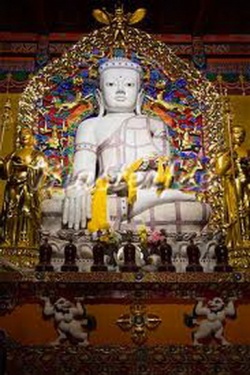Bodyless Dakini Dharma
These dakinis are called "wisdom dakinis" because they are connected with the wisdom or nirvanic side of existence; they are not part of the deluded or samsaric side of existence. Moreover, all the wisdom dakinis mentioned in this book are connected with a path that leads from delusion back to wisdom, the Buddhist Vajra Vehicle, and therefore are vajra dakinis. There are many vajra dakinis in the Vajra Vehicle, each with her own level of importance. The most important one from a practitioner's perspective is the main yidam or deity of the higher tantras, Vajrayogini. As above, "vajra" refers to the vajra-like-meaning indestructible and unchanging-inner reality of every being which the Vajra Vehicle takes and uses as the path back to enlightenment. The word "yogini" comes from the word "yoga". Yoga in general means "a practice for joining with reality" and in the Vajra Vehicle it means a practice for joining back with one's own vajra reality. A yogi is a male connected with the practice of yoga and a yogini a female. In other words, Vajrayogini is the vajra dakini through whom one practises the path of re-unification with one's own vajra reality. The Thorough Explanation commentary in this book gives a similar explanation of how the name "Vajrayogini" comes about, an explanation which will further help to understand the name. Vajrayogini is the name of a vajra dakini who is a principal deity in the practice of the Vajra Vehicle. There are many forms of Vajrayogini, each with her own name and characteristics. This book is about a particular one who has a feature of being strongly connected to the dharmakaya. She is called the "Bodyless Dakinii" where "bodyless" is a synonym for dharmakaya in Buddhist terminology. Several forms of Vajrayogini were brought into Tibet from India during the early days of Tibetan Buddhism. The Thorough Explanation commentary in this book mentions a number of them as it carefully identifies the Bodyless Dakini. The names of these various forms of Vajrayogini might not be well-know to non-Tibetan readers but they are all well-known within Tibetan tradition. There is another form of Vajrayogini who is mentioned frequently in this book. She has a small sow's head on her head. "Sow" in Sanskrit is "varahi" so this form of Vajrayogini is called "Vajravarahi". Pigs are symbols of ignorance and the sow's head of Vajravarahi is a symbol of vajra ignorance. In this case, the sow does not represent that the ignorance of samsara per se has been overcome but represents the vajra ignorance of reality. Vajravarahi is regarded as the inner aspect of the more general Vajrayogini, an aspect which is more closely connected with both sambhoga and dharmakayas. The Bodyless Dakini is similar to Vajravarahi in this respect but not the same. Vajravarahi is part of the general iconography of Vajrayogini where the Bodyless Dakini is a specific form of Vajrayogini used for practice. Vajravarahi is often used as a personification of the female aspect of reality and in this book she is mostly used in that sense. For example, Tillipa received many teachings from ultimate space in both male and female aspects. He received the Chakrasamvara teachings from Chakrasamvara as the male embodiment of the ultimate space and the vajradakini teachings from Vajravarahi as the female embodiment of that space. In this book, Vajravarahi mostly refers to that kind of embodiment functioning as a teacher.
ORIGIN OF THE BODYLESS DAKINI TEACHING The great Indian siddha Tillipa is famous for having received teachings directly from the dharmakaya. He said that he had two types of gurus, the non-human guru Vajradhara who he met in person and several human gurus who were great Indian siddhas of his time. In addition to those sources of teaching, he went to the realm of the dakinis and demanded of them that they give him the tantras and teachings of Chakrasamvara. He was successful in his quest and not only obtained those teachings of the heruka but also obtained the dakini teachings that go with it. He received the dakini teachings in person from the very source, Vajravarahi, the ultimate, enlightened dakini. These teachings were specifically called "The Bodyless Dakini" teachings.
KEY FEATURES OF THE BODYLESS DAKINI TEACHING In Bodyless Dakini dharma teaching, the term "bodyless" is a code word for "dharmakaya". In other words, the Bodyless Dakini teaching is a teaching of the practice of the dakini Vajrayogini which comes with a particular emphasis on dharmakaya. One of the features of the Bodyless Dakini teaching is that its empowerment is an un-elaborate one, meaning that it does not have many rituals in the procedure, a feature which fits with its emphasis on dharmakaya. It conducts the empowerment through a set of four signs which are presented to the disciple. These signs transmit the meaning of the four empowerments which constitute the whole empowerment. In this empowerment few words are used; the four signs are the means for conveying the whole meaning of the empowerment. Again, this fits with the emphasis on dharmakaya wisdom which is the ultimate non-concept. The four empowerments constituting the empowerment of the Bodyless Dakini are those of enlightened body, speech, and mind, and then the fourth, the wisdom empowerment. Note that the name is "bodyless". Some have suggested that the name should be translated as "formless" because of an association that has developed in some Western dharma centres between the word "formless" and "dharmakaya" or other, ultimate practices. Nonetheless, the term used is "bodyless", not "formless". The Thorough Explanation commentary text included in this book clearly explains the meaning of "bodyless" and how it relates to dharmakaya and the terms form and formless, too.
